Podcasts are one of THE best ways to drive high-converting traffic to your offers.
When done right, you’re capturing people’s attention for up to an hour (or longer, in some cases) at a time, making this one of the most captivating types of content ever.
And when it comes to growing your business using a podcast, there’s really only one thing you need to make sure you’re doing every day…
Check out this Tweet to see what we mean:

So if you want to experience explosive growth on your podcast?
The first step is making sure you’re actually recording episodes.
Pretty simple, right?
The second step is making sure you’re doing everything you can to distribute your podcast episodes in the RIGHT way.
In this guide, we’re going to break down 8 different strategies you can use to experience explosive growth for your podcast, as simply and as effectively as possible.
Let’s kick things off with the first strategy.
Launch on Your Social Media Channels
If you already have an established presence on social media, launching or sharing your podcast on these channels allows you to capitalize on your existing following.
With a built-in audience, you can encourage your followers to tune in and share your episodes.
And even if you don’t already have an audience right now, you can use your podcast launch to start drumming up attention and bringing in new followers.
The potential to massively grow your podcast right out of the gate by launching onto social media is huge.
Take a look at the growth Tim Suolo experienced after launching the Ahrefs podcast:
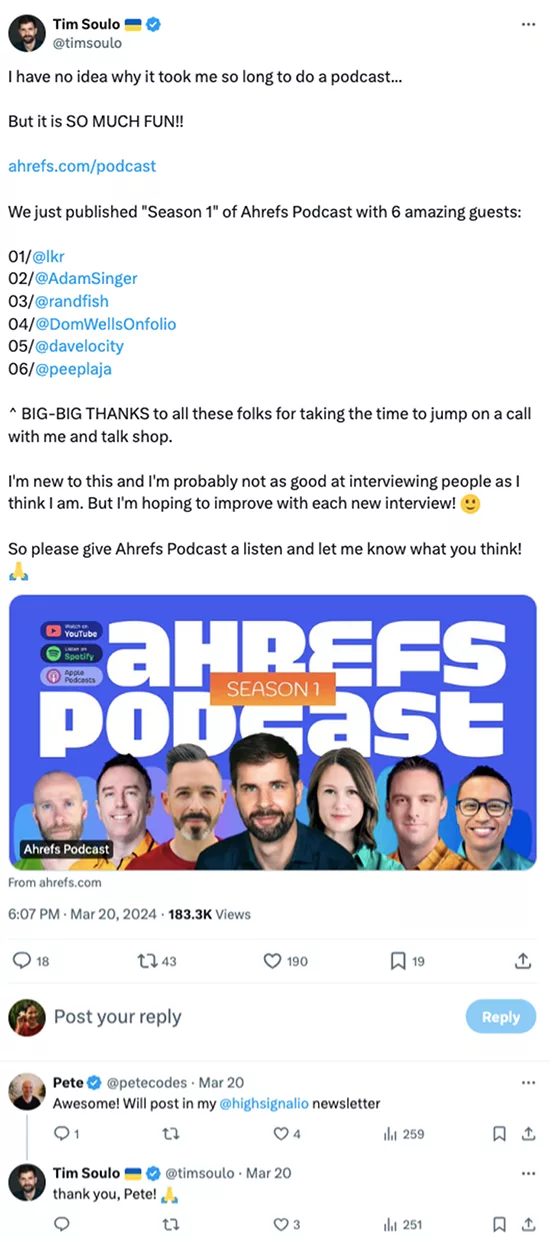
He received over 180,000 views on his podcast launch announcement.
That’s insane!
And that wasn’t all his own audience, either.
So before anyone starts saying “well, it’s Ahrefs, of course it was successful”, stop and take a look at the number of shares the post received.
When Tim announced the podcast launch, the post was shared 43 times — just on LinkedIn.
When you add in shares from other platforms, like Facebook, Instagram, and X (Twitter), he could have easily received hundreds of shares.
That’s access to entirely new audiences.
All because he chose to announce the launch on social media.
Then you take a look at the reactions and comments he got on the post:

All of that added up means the algorithm is putting his post in front of more and more people.
But Tim took it one step further.
He also posted it to his Instagram feed as a Short:

Then, he sent out the announcement to his email list:
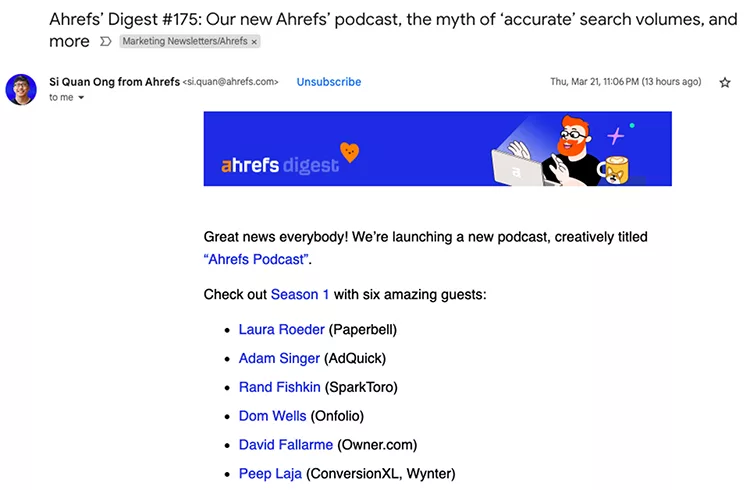
When you’re tapping into each of these separate channels, the growth you can experience right out of the gate is pretty insane.
But don’t get discouraged if you don’t already have a built-in audience of rabid followers.
Instead, focus on building relationships and making sure the episodes you release are something people want to tune into.
In the beginning, if you don’t already have an audience, you’ll have to get the ball rolling.
When you do that, though, each new episode you release gets more and more traction.
Then, over time, you can become known as a podcast that’s worth paying attention to.
Highlight Your Podcast on Social Media for Evergreen Growth
To make the most out of social media, you want to do more than just post your episodes.
You also want to use the platforms you’re on as a way to let people know your podcast exists — and how they can access it.
Including links to your podcast inside of your bio and about sections is a great way to drive new people to your podcast every day.
For example, check out how David Perell promotes his podcast on his Twitter (X) bio:

Then, whenever someone browses to his profile page and clicks the link in his bio, they’ll be taken to a landing page that includes various different links.
One of those links takes people directly to his Spotify channel, as well as his Apple channel.
You’ll also notice that one of the links takes people to his most popular episode, helping that particular episode gain even more traction and capture even more attention.

You can also plug your podcast link into your Instagram bio.
Here’s how Marie Forleo positioned her podcast in her IG bio:
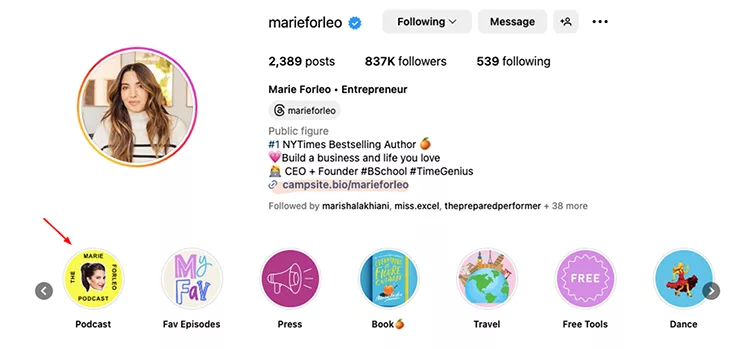
Then, similar to David Perell, when Marie’s followers click on her bio and then click through her Campsite link, they’re taken to a landing page that gives them a variety of places to go.
On Marie’s Campsite profile, though, she has her latest episodes posted front and center.
Take a look:

Then, you can use the Highlights feature on Instagram the generate even more attention for your podcast:

The big takeaway here, though, is that you can drive evergreen growth for your podcast just by using the features that social media platforms give you.
Nearly every platform you’ll build a following on will let you customize your bio.
Your bio section is a great place to include the links because as you’re interacting with other people on the platform, they will click through to see what you’re about — finding your podcast.
If it’s interesting enough, they’ll listen to it and possibly even share it with their own followers.
Share Teaser Clips on Social Media
During each interview or episode, you’re going to have moments that your audience needs to hear — but may not necessarily have the time to sit through an entire episode for.
These “hot takes” can be turned into clips and used on your social media platforms and email list to drive even more traffic to your current (and future) episodes.
What you’ll find is that they’re also one of the best pieces of content you can publish, too.
Especially when you realize that they’re already created and all you have to do is clip them out of each of your episodes once you make the episode live.
A standard operating procedure is to release the episode, announce it on social media and your email list, and then begin dropping teaser clips throughout the week.
This strategy will drive a consistent flow of traffic in between your episodes while driving a ton of new followers with each new clip.
To see what we mean, take a look at this clip from Ramit Sethi:

The reality is, most people will be too busy to listen to every single episode of your podcast.
Which is fine.
Because when you release clips, if someone is interested in what they hear in the teaser, they’ll set aside time to listen to the episode.
That may be in the car on their drive to work, in the gym, or while they’re in the shower.
Whatever the case may be, though, if they only saw your initial episode drop with a few bullet points, they may not have been enticed to watch the episode.
After seeing the teaser they’ll tune in and keep an ear out for the specific section you tased them with.
These 15-60 second clips are incredibly powerful when done the right way.
Before releasing them, you want to make sure you’re grabbing the right clips from your episode.
You want them to be entertaining, educational, or thought-provoking in some way.
The clips, themselves, should provide standalone value to your audience.
Like this one from Pe:p Laja:

You can see he’s added captions over the clips to make them more accessible and engaging so even if someone doesn’t have their sound turned on, they can still get the needed context.
You’ll also want to make sure that the clips are formatted for each specific platform — ie: Instagram prefers vertical videos while Twitter (X) and LinkedIn prefer horizontal videos.
Here’s an example for LinkedIn:

If Mel Robbins changed the format to horizontal, the clip would fill the entire screen.
Like this example from Twitter:

Subtle difference but one that can make a big impact when it comes to grabbing attention.
Now, to make this as easy as possible to do, you can use tools like Repurpose.io and Wavve.co to create snippets and teasers.
Build a Podcast Landing Page
Having a dedicated landing page for your episodes is another great way to both promote your podcast while also providing information for people who may have just stumbled onto it.
Your landing page serves as a central hub for listeners to discover, learn about, and engage with your show.
Check out this example from Ramit Sethi:

On Ramit’s landing page, you can learn a bit about the podcast.
If a sponsor listened to one of his episodes and wanted to advertise, they would be able to quickly find out how to get in touch with him for a placement on one of his shows.
This is easy to set up, too.
If you’re using a tool like ClickFunnels, you can choose a template that matches your branding.
(Click here for a free 14-day trial if you haven’t already experienced ClickFunnels!)

Once you’ve chosen a template, you can edit it without having any coding knowledge or having to hire a developer to do the work for you.
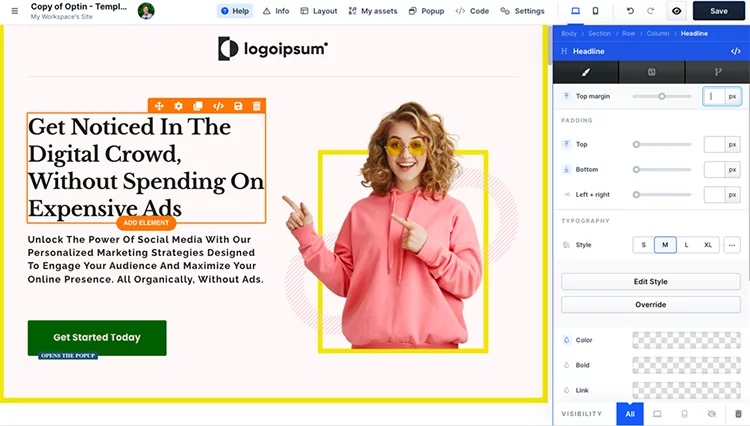
Using the built-in drag-and-drop editor, you can fully customize the landing page so your visitors know exactly where to go to get what they’re looking for.
As you’re building your podcast landing page, there’s a few things you want to make sure you include.
1) Podcast Branding: The page should prominently display your podcast’s name, logo, and artwork to create a strong visual identity and make it easily recognizable.
2) Compelling Description: A clear, concise, and engaging description of your podcast, highlighting its unique value proposition and target audience.
3) Latest Episodes: A section showcasing your most recent episodes, with titles, descriptions, and playable audio embeds to give visitors a preview of your content.
4) Email Capture: An option for visitors to sign up for your newsletter or mailing list to receive updates, bonus content, or exclusive offers.
5) Host Information: A brief bio and photo of the host(s) to help listeners connect with the people behind the podcast and establish credibility.
6) Subscribe Buttons: Prominent calls-to-action and links to subscribe to your podcast on popular platforms like Apple Podcasts, Spotify, Google Podcasts, and Stitcher.
7) Testimonials and Reviews: Featured quotes from listeners or media outlets praising your podcast, building social proof and encouraging others to tune in.
Here’s a few examples of each of these elements in action:

Above, you can see an intro for the podcast host.
Below is a listing of each Ahrefs podcast episode.

The example below makes it easy for her visitors to find their own preferred platform for Marie Forleo’s podcast episodes.

Lower in the page, Marie includes reviews so that new visitors know the podcast is worth listening to.

Each of these elements, when put together, make your podcast more attractive.
You can include all of them on your landing pages when you build them in ClickFunnels.
Collaborate with Guests to Promote it
Some of the best podcasts in the world don’t revolve just around the host.
They’re great because they connect with guests and introduce people to new ideas.
This strategy works incredibly well but has one benefit that many people don’t realize…
When you partner with guests, especially those that have a following, too, you can get them to promote the episode to their own audience.
That lets you leverage their existing networks to attract new listeners while growing your own audience.
And since the guests are usually excited to be interviewed on a podcast, most times you don’t even have to ask them to share it — they’ll do it because they want to.
Like this mention from Andrew Chen on his newsletter:

When Andrew was interviewed, he was excited to tell his audience about it.
The announcements can start even before the podcast is recorded, too.
Like this example from Tim Suolo:

He started promoting Omer Khan’s “The SaaS Podcast” before he was ever interviewed, helping raise awareness and generate attention long before his episode was recorded or released.
To nail this strategy, there are 3 things you want to do.
First, you want to make sure you have the promotional assets needed to promote your podcast.
Without those, your guests may not be sure exactly how you want to show up.
Second, you want to coordinate your episode launch timing with your guest.
If they are in the middle of a launch, for instance, they may not want to distract their audience with a podcast announcement.
By syncing up your launch with a time they can actively promote the episode, your release will gain a lot more traction.
Finally, you want to engage with their content once they make the announcement.
Here’s an example:

When David Perell let people know that Shaan Puri was on his podcast, he encouraged Shaan to interact with his audience.
This helps raise more awareness while tapping into the algorithm for both of their audiences.
Optimize for Podcast Catchers & Directories
While the promotion strategies we’ve given you so far rely on you or your guest promoting your podcast and episodes, software known as Podcast Catchers and podcast directors can extend your reach, too.
Podcast Catchers are software that allows users to subscribe, download, and listen to podcasts.
Examples of popular Catchers are Apple Podcasts, Spotify, Google Podcasts, Stitcher, Overcast, and Pocket Casts.
These catchers and directories are online platforms that index and categorize podcasts, making it easy for listeners to discover new shows based on their interests or what’s popular right now.
To tap into this free traffic strategy, you’ll want to make sure your podcast is actually listed.
To get started, submit your podcast’s RSS feed to the most popular directories — Apple Podcasts, Spotify, and Google Podcasts.
This will help increase your visibility while making it accessible to new listeners.
Here’s an example from Shaan Puri and Sam Parr listing their podcast with major directories:
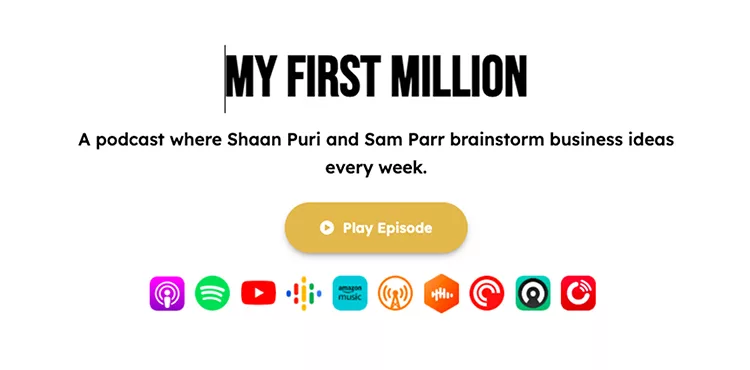
Then, you’ll want to optimize your podcast’s metadata.
Provide accurate, compelling, and keyword-rich information for your podcast title, description, categories, and episode details to help improve your discoverability and search rankings within each of the directories.
For example, the description below is clear, keyword-rich, and lays out key benefits:

Once you’ve done that, you’ll want to encourage your audience to rate and review your episodes.
Positive reviews can help improve your show’s credibility, visibility, and ranking, helping you attract even more new listeners.
Publish on YouTube
When it comes to gaining traction on your podcast, one of the best things you can do is start uploading your episodes directly to YouTube.
YouTube is the second-largest search engine in the world, with billions of active monthly users, giving you access to a HUGE boost in traffic.
For example, if you search for “breaking bad habits”, you’ll find the podcast below:

By publishing your podcast episodes directly to YouTube, you can optimize your content for Google’s search algorithm, too, letting you show up in search results on Google itself.
For instance, when I searched for “garden business Australia” in Google, I found this podcast:

When you do this, though, you’ll want to use similar strategies to publishing on podcast directories.
You want to make sure that you’re including keyword-rich episode titles, detailed descriptions, and timestamps so the Google algorithm knows what the episode is about and who they should be showing it to.
Taking this one step further, if you actively search for keywords that people are already looking for using the Google Keyword Planner, you can publish episodes that you know people are already looking for.
So if someone searches for “how to grow a self-sustaining garden”, they’ll be presented with a wide range of options in the search results.
Some of those options will be blog posts and articles.
But some of them will be YouTube videos, too.
If someone would prefer watching a video or listening to a podcast, they’re likely going to click the YouTube listing instead of reading through a blog post or article.
And, many times, since YouTube has more authority (in terms of the Google algorithm) than many people’s websites, the YouTube videos will appear higher than their own blog posts.
That means you can tap into high-converting Google traffic just by publishing your episodes to YouTube using keywords you’ve uncovered with the Google Keyword Planner.
Collect Reviews & Shares from Listeners
Now, when you want to make an impact on potential listeners, one of the easiest ways to do it is by showing them how much other people love your podcast.
If a new listener lands on your podcast on one of the directories (or even your own landing page) and they don’t see any reviews?
What do you believe they’ll think (or not think) about your show?
Chances are, they’ll subconsciously check out and go looking for something else unless you’ve done an amazing job at grabbing their attention with your bio or episode titles.
But if they see a stack of positive reviews, they’ll do a double take and want to figure out what all the fuss is about.
They’ll spend time reading through your reviews, seeing what other people have to say about it, and make a decision to listen to it based on what they’ve seen other people say.
That can’t happen, though, unless you’re actually asking people for reviews.
Like this email from Jon Morrow:

In the email, he’s making an announcement that his audience will love — his newest podcast episode.
Then, at the end, he makes an ask.
He’s letting people know that he would be incredibly appreciative if his listeners could take a second to leave him a review.
You don’t just have to ask them for a review, either.
You could also ask them if they could share your podcast with their audience.
Some people, like Lenny Rachitsky, even use a giveaway to gain more episode shares:
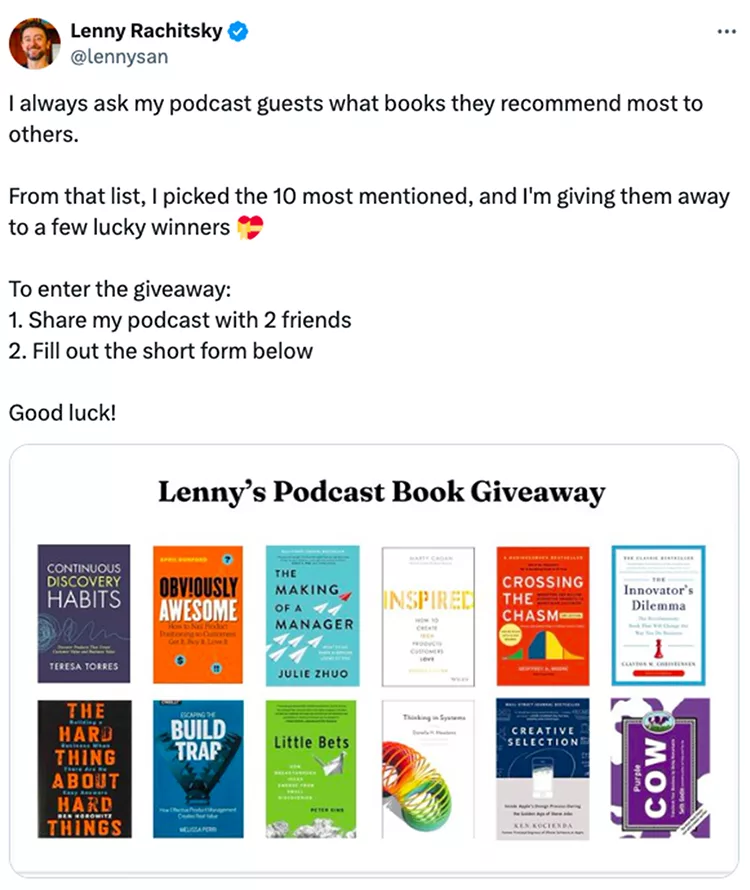
Then, hosts like Joe Pompliano turn it into a full-blown contest:

In this example, he’s giving away $500 to two lucky winners who retweet his post (gaining him more followers) and subscribe to his podcast (gaining him new listeners).
In terms of advertising, depending on the number of new followers and listeners he gains, spending $1,000 to generate attention could be one of the most profitable things he does.
One thing is certain, though, that it will get people talking.
You can take a look at the stats on the post — 1,200 comments, 1,500 shares, and 1,800 likes — that it’s doing exactly what it was intended to do.
And when you have each of the other podcast growth strategies in place that we’ve given you here, it’s easy to capitalize on contests and giveaways like this.
The key, though, revolves around making sure you have a central location where people can find out more about your show and know where to go when new episodes get released.
The combination of a podcast landing page and your email list is THE most potent way to capture the attention you’re generating using the other strategies we’ve given you.
And if you don’t already have those in place, you can use ClickFunnels free for 14 days while you’re getting everything set up.
Then you can launch on social media, share your teasers throughout the week, and start collaborating with other people so you gain even more exposure.
Once you put each of these in motion, your podcast will experience explosive growth.





